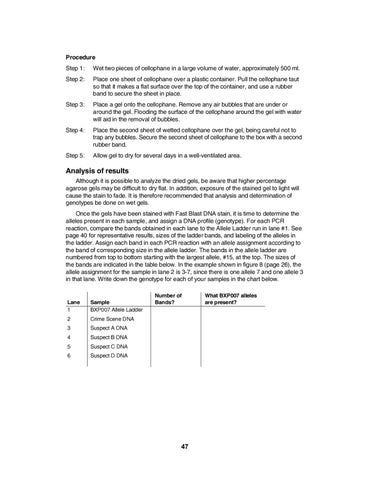Procedure Step 1:
Wet two pieces of cellophane in a large volume of water, approximately 500 ml.
Step 2:
Place one sheet of cellophane over a plastic container. Pull the cellophane taut so that it makes a flat surface over the top of the container, and use a rubber band to secure the sheet in place.
Step 3:
Place a gel onto the cellophane. Remove any air bubbles that are under or around the gel. Flooding the surface of the cellophane around the gel with water will aid in the removal of bubbles.
Step 4:
Place the second sheet of wetted cellophane over the gel, being careful not to trap any bubbles. Secure the second sheet of cellophane to the box with a second rubber band.
Step 5:
Allow gel to dry for several days in a well-ventilated area.
Analysis of results Although it is possible to analyze the dried gels, be aware that higher percentage agarose gels may be difficult to dry flat. In addition, exposure of the stained gel to light will cause the stain to fade. It is therefore recommended that analysis and determination of genotypes be done on wet gels. Once the gels have been stained with Fast Blast DNA stain, it is time to determine the alleles present in each sample, and assign a DNA profile (genotype). For each PCR reaction, compare the bands obtained in each lane to the Allele Ladder run in lane #1. See page 40 for representative results, sizes of the ladder bands, and labeling of the alleles in the ladder. Assign each band in each PCR reaction with an allele assignment according to the band of corresponding size in the allele ladder. The bands in the allele ladder are numbered from top to bottom starting with the largest allele, #15, at the top. The sizes of the bands are indicated in the table below. In the example shown in figure 8 (page 26), the allele assignment for the sample in lane 2 is 3-7, since there is one allele 7 and one allele 3 in that lane. Write down the genotype for each of your samples in the chart below.
Lane 1
Sample BXP007 Allele Ladder
2
Crime Scene DNA
3
Suspect A DNA
4
Suspect B DNA
5
Suspect C DNA
6
Suspect D DNA
Number of Bands?
47
What BXP007 alleles are present?
